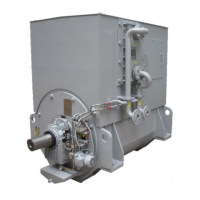
Do you have a question about the Siemens 1D Series and is the answer not in the manual?
| Brand | Siemens |
|---|---|
| Model | 1D Series |
| Category | Portable Generator |
| Language | English |
Explains warning terms like DANGER, WARNING, CAUTION, RECOMMENDATION.
Covers essential safety precautions for operation and handling.
Details the coding system used for generator identification.
Outlines the general technical specifications and available types.
Defines the standard naming convention for generator ends (DE, NDE).
Describes the systems used for machine cooling and air circulation.
Details the construction and components of the generator's rotor.
Explains the structure and windings of the generator's stator.
Discusses the types of bearings used and their maintenance.
Covers the electrical properties and performance of the generator.
Specifies requirements for handling asymmetric load conditions.
Defines limits and requirements for short-circuit events.
Describes the intended applications and environments for the generators.
Lists the standards and regulations the generator design complies with.
Highlights critical safety precautions during transport and storage.
Details the environmental requirements for proper generator storage.
Specifies procedures for storing generators with rolling bearings.
Explains protective measures for metal components.
Provides instructions for storing the generator horizontally.
Outlines steps for commissioning after storage.
Describes the use and inspection of sealed packaging for components.
Specifies the schedule for checking stored machines.
Details procedures for monitoring machines in storage.
Emphasizes adherence to safety guidelines during installation and operation.
Details essential steps to take before installing the generator.
Explains checks required for the generator's mounting foundation.
Provides instructions for physically installing the generator.
Describes procedures for lubricating bearings.
Guides on connecting lubrication systems to the bearings.
Details on connecting cooling systems.
Covers critical alignment procedures for rolling bearings.
Explains the process of aligning generator and drive shafts.
Details on aligning the coupling between machines.
Covers critical alignment procedures for slide bearings.
Describes methods to fix the generator's position.
Outlines procedures for testing stator winding insulation.
Details the specific insulation testing process.
Provides methods for drying the generator windings.
Covers all electrical connection aspects of the generator.
Details how to connect the generator's electrical terminals.
Explains protective measures against overcurrent and hazardous situations.
Covers the initial startup and operational procedures.
Provides essential guidelines for the generator's normal operation.
Lists the schedules for routine maintenance checks.
Describes the first level of preventive maintenance.
Describes the second level of preventive maintenance.
Describes the third level of preventive maintenance.
Explains the importance and use of the operational logbook.
Lists common mechanical issues and their remedies.
Details common electrical faults and their solutions.
Continues the list of electrical faults and their remedies.
Emphasizes safety during all maintenance tasks.
Lists fundamental safety protocols for electrical work.
Describes how to check the generator's insulation integrity.
Details the maintenance procedures for generator bearings.
Provides specific maintenance instructions for antifriction bearings.
Provides specific maintenance instructions for sliding bearings.
Details the steps for disassembling and reassembling specific machine models.
Outlines the basic functionality of the control system.
Describes the adjustable limits for terminal voltage.
Specifies the precision of the voltage regulation system.
Discusses the suitability and procedures for parallel operation.
Provides general information about the neutral wire's behavior.
Lists contact details for the primary manufacturer service.
Provides global support contact information.